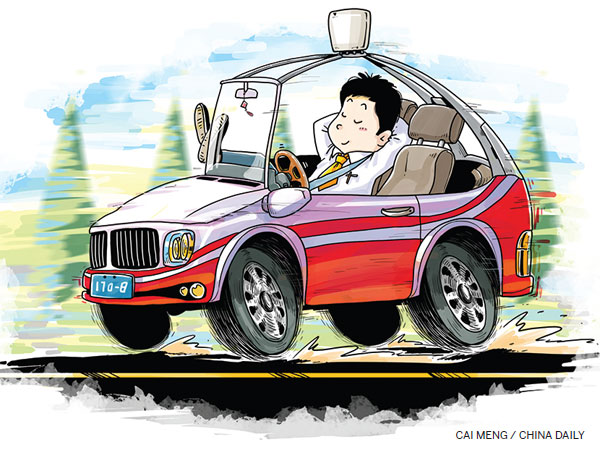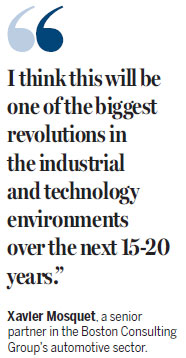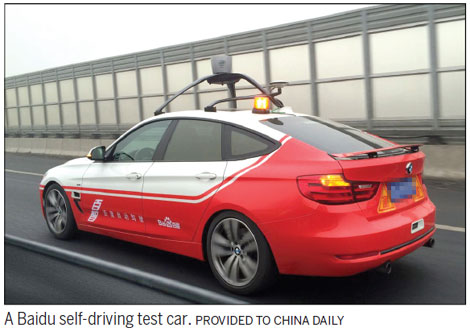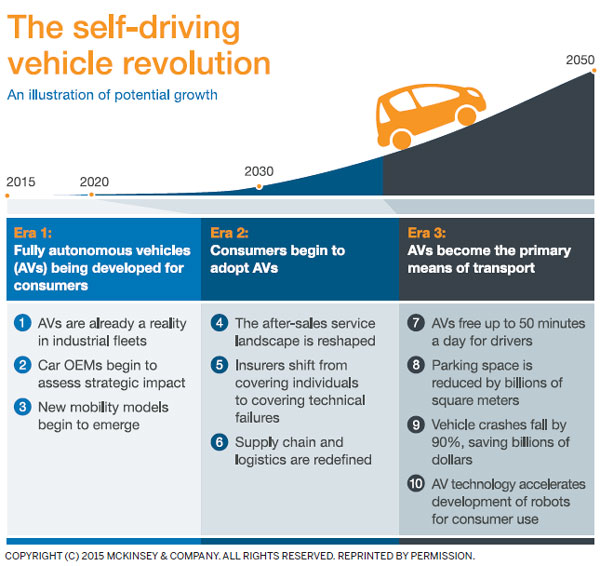The race to get rid of human drivers
Updated: 2016-05-06 10:26
By Paul Welitzkin(China Daily USA)
|
|||||||||
The date on when they will be fully deployed may vary, but companies in China and the US are pushing hard to put autonomous or self-driving vehicles on the road, Paul Welitzkin reports from New York.
Simply put, it's scary: A piece of mobile steel machinery weighing thousands of pounds operating without the guidance of a human. But autonomous or self-driving vehicles, once confined to the minds of science-fiction writers and readers, may be close to becoming a reality.
"We are likely to see autonomous cars that drive at low speeds by 2021 or 2022," said Xavier Mosquet, a senior partner in the Boston Consulting Group's automotive sector and the head of the firm's Detroit office, in an interview. "You already have Google cars that are reasonably autonomous in San Francisco and there are also experiments in Tokyo and Singapore."

Thirteen companies have been given permission to test autonomous vehicles on the roads of California. China's Chongqing Changan Automobile Co said in April it completed a 1,200-mile trip from Chongqing to Beijing testing a self-driving car as part of its campaign to produce highly automated vehicles.
Lex Kerssemakers, CEO of Volvo North America, expects to see self-driving vehicles on the streets of Beijing or New York sometime after 2020. "I think it will come a lot sooner than most are predicting," he said.
China and the US are major players in the race to the vehicles. China seems particularly well suited for self-driving cars. It is plagued by air pollution, traffic congestion and erratic driving. More than 200,000 people die each year in road accidents in China, according to the World Health Organization.
US urban areas

The US is also a proving ground for the technology. Its urban areas also struggle with traffic gridlock and air pollution. Both nations have thriving technology sectors. The US auto industry is well established while China, now the world's largest auto market, is quickly developing an auto-production sector.
The race to develop autonomous vehicles has attracted many companies ranging from start-ups to those in the Fortune 500. Big names in the automotive industry have committed resources to their development, including General Motors, Ford Motor Co, Nissan and Tesla Motors.
Eric Dennis of the Center for Automotive Research in Ann Arbor, Michigan, said the word "autonomous" implies self-agency and independence from external control.
"These vehicles will not likely be autonomous. They will be automated by human programmers to complete tasks given to them by human operators, and likely reliant on connectivity to receive task instructions and information about the world that allows them to carry out these tasks," he wrote in an e-mail.
Dennis believes that the development of self-driving or autonomous vehicles will take place in stages.
He said several automakers will offer vehicles in the US, China, and elsewhere that can operate hands-free and feet-free in simple highway driving by "sensing and responding to pavement markings, barriers, and other vehicles. However, those vehicles are not completely reliable and cannot operate autonomously in complex urban driving environments as the human driver must frequently assume control".
Shuttle system
Many cities are beginning to experiment with low-speed driverless shuttle systems that do not even have manual controls (i.e., brakes and steering wheels). "However, these systems are very limited in function because they usually operate in low-traffic environments and only on a specific pre-determined route," said Dennis.
Other companies, such as Google, are developing autonomous technology that does allow autonomous operation in complex urban driving environments. Dennis said that while this technology is promising, it isn't yet available to consumers and it's uncertain when it may become widely available.
"If and when it does become available, it is likely to be available only in specific locations at first. This approach requires labor-intensive creation of digital 3D maps that provide information to the car about how to drive. Thus, Google's cars can now only operate in a few locations, and mostly operate in Mountain View, California. The replacement of human-driven vehicles by self-driving vehicles on a global scale is likely to proceed slowly over several decades, and will probably never be complete," added Dennis.
Mosquet's Boston Consulting Group is predicting that by 2025 vehicles with some autonomous features such as highway autopilot or autonomous valet parking are expected to reach 12 to 13 percent of car sales globally, representing a market of about $42 billion for those features, excluding the base price of the cars.
Boston Consulting also predicts that by 2035 sales of fully-autonomous vehicles will make up nearly 10 percent of the global market. In 2014, IHS Automotive said global vehicle sales totaled about 82.8 million.
Google and Baidu - Internet search titans in the US and China respectively - are actively developing autonomous cars. The two represent a growing number of non-automotive companies that are eager to participate in the development of the technology and the vehicles.
Mosquet believes that Baidu, Google and other Internet-related companies want to showcase their expertise and carve out a potentially huge and profitable niche as automotive suppliers.
"They (Google and Baidu) have the skill set in software and mapping to become tech producers for autonomous cars," he said.
Dennis noted that Google and Baidu's interest may extend to the broader business model of the companies which is to collect and utilize data.
"The travel habits of individuals using these services may provide many opportunities for ancillary business models such as consumer marketing and partnerships with municipal transit agencies. They may also offer transportation options to the mobility challenged and improve the world in various ways," he added.
Mosquet said that the two companies' location-based services will grow in significance in the marketing of other products and services. He also believes that the ancillary benefits of developing the technology will evolve into a major business.
Baidu reportedly has a goal of developing self-driving shuttles that run in a standard loop in a limited area in China by the end of 2018, The Wall Street Journal reported. Baidu's autonomous-vehicle strategy is being led by Andrew Ng, the company's chief scientist and a professor of computer science at Stanford University in Palo Alto, California.
In an interview, Ng said there are obstacles to developing a safe autonomous or driver-less car. "When a car driven by a human approaches a construction site, the human will recognize the construction worker as they gesture to stop or proceed. An autonomous car can't recognize the worker, his/her gestures or any signs they have.
"We could give the construction worker technology to communicate start and stop instructions to the autonomous car, perhaps through a signal that would be recognized via a receiver in the vehicle," Ng said.
Ng said Baidu is interested in the technology because it can reduce accidents, save time and has the potential to become a huge business.
Start small
Ng believes that the most progressive path for the self-driving vehicle in China and the US is to mimic the US space program, which took measured steps in landing a man on the moon. The US learned how to launch a rocket, circle the Earth, have it dock with another spacecraft and then practiced those same steps while circling the moon.
"We should start in a small region and make changes to infrastructure like a bus stop. Once you nail that one stop you can very quickly grow the region from one bus stop to 10 and then maybe cover an entire city," he said. "Those of us who work on this should be focused on saving lives. No one has ever won a race by staring in the rear-view mirror all the time."
Mosquet believes that the race to develop autonomous vehicles could produce the same ancillary benefits that came from the space race in the 1960s between the US and Russia.
"I think this will be one of the biggest revolutions in the industrial and technology environments over the next 15-20 years," Mosquet said.
Research and development is expected to spill over into sectors like software and computer chips according to John Capp, director of advanced safety and vehicle programs for General Motors.
"Increased driving automation and even fully autonomous driving will require even better sensing technologies (cameras and radar), faster computer processing capability, detailed maps and connectivity. We intend to take this in steps," Capp wrote in an e-mail.
"It's interesting to see some Chinese players establishing beachheads on the West coast of the US," Mosquet said. "I think Western players would also benefit from partnerships in China."
Baidu expects to start testing autonomous cars in the US soon, according to Ng. "We plan to test cars in the US just for research and not as a product," he said. "We are focused on building the technology in China."
Contact the writer at paulwelitzkin@chinadailyusa.com.


(China Daily USA 05/06/2016 page20)
- Inspection teams to cover all of military in anti-corruption drive
- Tornado, heavy rain batters Central China's Hunan
- Beijing to cut downtown population this year
- Palace Museum confirms ancient relics find
- Disney promises ‘safe, pleasing service of high quality’
- Couple detained for selling their two sons

 Raging wildfire spreads to more areas in west Canada
Raging wildfire spreads to more areas in west Canada
 World's first rose museum to open in Beijing
World's first rose museum to open in Beijing
 Teapot craftsman makes innovation, passes down techniques
Teapot craftsman makes innovation, passes down techniques
 Top 8 iOS apps recommend for mothers
Top 8 iOS apps recommend for mothers
 Five things you may not know about the Start of Summer
Five things you may not know about the Start of Summer
 Art imagines celebrities as seniors
Art imagines celebrities as seniors
 Japanese animator Miyazaki's shop a big hit in Shanghai
Japanese animator Miyazaki's shop a big hit in Shanghai
 Star Wars Day celebrated around world
Star Wars Day celebrated around world
Most Viewed
Editor's Picks

|

|

|

|

|

|
Today's Top News
Liang avoids jail in shooting death
China's finance minister addresses ratings downgrade
Duke alumni visit Chinese Embassy
Marriott unlikely to top Anbang offer for Starwood: Observers
Chinese biopharma debuts on Nasdaq
What ends Jeb Bush's White House hopes
Investigation for Nicolas's campaign
Will US-ASEAN meeting be good for region?
US Weekly

|

|









